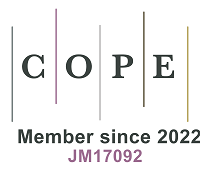REFERENCES
1. Buccina J. The development of a global treaty on persistent organic pollutants. persistent organic pollutants; 2003: 123-201.
2. UNEP. Dralt revised guidance on the global monitoring plan for persistent organic pollutants, UNEP/POPS/COP5/INF/27. Available from: https://www.informea.org/zh-hans/draft-revised-guidance-global-monitoring-plan-persistent-organic-pollutants [Last accessed on 28 Aug 2023].
3. UNEP. Final act of the conference of plenipotentiaries on the Stockholm Convention on persistent organic pollutant. Available from: https://www.scirp.org/reference/ReferencesPapers.aspx?ReferenceID=1726464 [Last accessed on 28 Aug 2023].
4. UNEP. Report of the Conference of the Parties of the Stockholm Convention on Persistent Organic Pollutants on the work of its fourth meeting. Available from: http://chm.pops.int/portals/0/repository/cop4/unep-pops-cop.4-38.english.pdf [Last accessed on 28 Aug 2023].
5. Zhang J, Wang X, Gong P, Wang C, Sun D. Seasonal variation and source analysis of persistent organic pollutants in the atmosphere over the western Tibetan Plateau. Environ Sci Pollut Res Int 2018;25:24052-63.
6. Lv M, Luan X, Guo X, et al. A national-scale characterization of organochlorine pesticides (OCPs) in intertidal sediment of China: occurrence, fate and influential factors. Environ Pollut 2020;257:113634.
7. Yu H, Liu Y, Shu X, Ma L, Pan Y. Assessment of the spatial distribution of organochlorine pesticides (OCPs) and polychlorinated biphenyls (PCBs) in urban soil of China. Chemosphere 2020;243:125392.
8. Zhang Y, Zhang H, Shi XM. Risk assessment of reuse of site contaminated by organic chemicals after soil remediation. Bull Soil Water Conserv ;30:203-7.
9. Luo Y, Yang R, Li Y, et al. Accumulation and fate processes of organochlorine pesticides (OCPs) in soil profiles in Mt. Shergyla, Tibetan Plateau: a comparison on different forest types. Chemosphere 2019;231:571-8.
10. Ding Y, Huang H, Chen W, et al. Background levels of OCPs, PCBs, and PAHs in soils from the eastern Pamirs, China, an alpine region influenced by westerly atmospheric transport. J Environ Sci 2022;115:453-64.
11. Ali U, Syed JH, Malik RN, et al. Organochlorine pesticides (OCPs) in South Asian region: a review. Sci Total Environ 2014;476-477:705-17.
12. Niu L, Xu C, Zhu S, Liu W. Residue patterns of currently, historically and never-used organochlorine pesticides in agricultural soils across China and associated health risks. Environ Pollut 2016;219:315-22.
13. Qu C, Albanese S, Li J, et al. Organochlorine pesticides in the soils from Benevento provincial territory, southern Italy: spatial distribution, air-soil exchange, and implications for environmental health. Sci Total Environ 2019;674:159-70.
14. Qu C, Albanese S, Lima A, et al. The occurrence of OCPs, PCBs, and PAHs in the soil, air, and bulk deposition of the Naples metropolitan area, southern Italy: implications for sources and environmental processes. Environ Int 2019;124:89-97.
15. Zhang A, Fang L, Wang J, et al. Residues of currently and never used organochlorine pesticides in agricultural soils from Zhejiang Province, China. J Agric Food Chem 2012;60:2982-8.
16. Fang Y, Nie Z, Die Q, et al. Organochlorine pesticides in soil, air, and vegetation at and around a contaminated site in southwestern China: Concentration, transmission, and risk evaluation. Chemosphere 2017;178:340-9.
17. Yuan GL, Qin JX, Li J, Lang XX, Wang GH. Persistent organic pollutants in soil near the Changwengluozha glacier of the Central Tibetan Plateau, China: their sorption to clays and implication. Sci Total Environ 2014;472:309-15.
18. Gai N, Pan J, Tang H, et al. Organochlorine pesticides and polychlorinated biphenyls in surface soils from Ruoergai high altitude prairie, east edge of Qinghai-Tibet Plateau. Sci Total Environ 2014;478:90-7.
19. Huang T, Guo Q, Tian H, et al. Assessing spatial distribution, sources, and human health risk of organochlorine pesticide residues in the soils of arid and semiarid areas of northwest China. Environ Sci Pollut Res Int 2014;21:6124-35.
20. Mao X, Yu Z, Ding Z, et al. Sources and potential health risk of gas phase PAHs in Hexi Corridor, Northwest China. Environ Sci Pollut Res Int 2016;23:2603-12.
21. Jia Z, Yuan L, Jiang Y, He R, Ding W. Status, distribution, source, and risk of polychlorinated biphenyl levels in soils of five cities from the Hexi Corridor, Northwest China. Environ Monit Assess 2023;195:282.
22. Gao F, Jia J, Wang X. Occurrence and ordination of dichlorodiphenyltrichloroethane and hexachlorocyclohexane in agricultural soils from Guangzhou, China. Arch Environ Contam Toxicol 2008;54:155-66.
23. Gao H, Dong JY, Wu JN. Transfer and fate of HCHs in Lanzhou region. Chin Environ Sci 2008; 28: 407-411. (In Chinese). Available from: https://kns.cnki.net/kcms2/article/abstract?v=3Nyamzb2at545_H2f2X6QtEzk7va_3J-lzhCN-y4N_3N3-LqAl7p4RqYgFO3RtX_-uaYtO4wVE85qLNO9yKlYPwFC9NeLS-a-RswpmIRzlGaoaaurGuPSBObVqj7aDVp&uniplatform=NZKPT&language=CHS [Last accessed on 28 Aug 2023].
24. Jiang Y, Yuan L, Liang X, Nan Z, Deng X, Ma F. Status, Sources and Potential Risk of Polycyclic Aromatic Hydrocarbons in Soils from Hexi Corridor in Northwest China. Bull Environ Contam Toxicol 2022;108:563-70.
25. Jiang YF, Wang XT, Jia Y, et al. Occurrence, distribution and possible sources of organochlorine pesticides in agricultural soil of Shanghai, China. J Hazard Mater 2009;170:989-97.
26. Li XY. Study on the inventories and numerical simulation of fate and transport of OCPs in Gansu Province. Master’s dissertation, Lanzhou University, Lanzhou 2011. Available from: https://kns.cnki.net/kcms2/article/abstract?v=3Nyamzb2at6lWhwjrTpupNNBrm63FjXN72X6hO2dcKzm34Otd0X1Bj4CeRB7t7BiiphfkVouMZ5RwbKaT1wt-CN9e5zRoALvCH2FiDSzZk6tldQpHHFABAamrCkulquE&uniplatform=NZKPT&language=CHS [Last accessed on 28 Aug 2023].
27. Tang D, Liu X, He H, Cui Z, Gan H, Xia Z. Distribution, sources and ecological risks of organochlorine compounds (DDTs, HCHs and PCBs) in surface sediments from the Pearl River Estuary, China. Mar Pollut Bull 2020;152:110942.
28. Syed JH, Malik RN. Occurrence and source identification of organochlorine pesticides in the surrounding surface soils of the Ittehad Chemical Industries Kalashah Kaku, Pakistan. Environ Earth Sci 2011;62:1311-21.
29. Pereira R, Monterroso Martínez MC, Martínez Cortízas A, Macías F. Analysis of composition, distribution and origin of hexachlorocyclohexane residues in agricultural soils from NW Spain. Sci Total Environ 2010;408:5583-91.
30. Lv J, Shi R, Cai Y, et al. Assessment of 20 organochlorine pesticides (OCPs) pollution in suburban soil in Tianjin, China. Bull Environ Contam Toxicol 2010;85:137-41.
31. Chen M, Chen L, Huang P. Residues and possible sources of organochlorine pesticides in surface soil of Urumqi. Chin Environ Sci 2013; 34: 1838-1846. (In Chinese). Available from: https://kns.cnki.net/kcms2/article/abstract?v=3Nyamzb2at6C0RMSPjzPBamnOG8jmy0VDoCKRUyO6vMQOv5JW376HrKYvxLv-U_PyrOi5qfP9fOhKQvUmwcEfMDdD0jqLuxc0Uc8tli6kELLGvo65tHVlWWTOfko0Q6K&uniplatform=NZKPT&language=CHS [Last accessed on 28 Aug 2023].
32. Fu S, Cheng HX, Liu YH, Xu XB. Levels and distribution of organochlorine pesticides in various media in a mega-city, China. Chemosphere 2009;75:588-94.
33. Zhang HB, Luo YM, Zhao QG, Wong MH, Zhang GL. Residues of organochlorine pesticides in Hong Kong soils. Chemosphere 2006;63:633-41.
34. Sun K, Zhao Y, Gao B, Liu X, Zhang Z, Xing B. Organochlorine pesticides and polybrominated diphenyl ethers in irrigated soils of Beijing, China: levels, inventory and fate. Chemosphere 2009;77:1199-205.
35. Chakraborty P, Zhang G, Li J, Sivakumar A, Jones KC. Occurrence and sources of selected organochlorine pesticides in the soil of seven major Indian cities: assessment of air-soil exchange. Environ Pollut 2015;204:74-80.
36. Bajwa A, Ali U, Mahmood A, et al. Organochlorine pesticides (OCPs) in the Indus River catchment area, Pakistan: status, soil-air exchange and black carbon mediated distribution. Chemosphere 2016;152:292-300.
37. Meijer SN, Halsall CJ, Harner T, et al. Organochlorine pesticide residues in archived UK soil. Environ Sci Technol 2001;35:1989-95.
38. Ene A, Bogdevich O, Sion A. Levels and distribution of organochlorine pesticides (OCPs) and polycyclic aromatic hydrocarbons (PAHs) in topsoils from SE Romania. Sci Total Environ 2012;439:76-86.
39. Yadav IC, Devi NL, Li J, Zhang G, Shakya PR. Occurrence, profile and spatial distribution of organochlorines pesticides in soil of Nepal: Implication for source apportionment and health risk assessment. Sci Total Environ 2016;573:1598-606.
40. Manz M, Wenzel KD, Dietze U, Schüürmann G. Persistent organic pollutants in agricultural soils of central Germany. Sci Total Environ 2001;277:187-98.
41. Yu HY, Li FB, Yu WM, et al. Assessment of organochlorine pesticide contamination in relation to soil properties in the Pearl River Delta, China. Sci Total Environ 2013;447:160-8.
42. Mishra K, Sharma RC, Kumar S. Contamination levels and spatial distribution of organochlorine pesticides in soils from India. Ecotoxicol Environ Saf 2012;76:215-25.
43. Pokhrel B, Gong P, Wang X, Chen M, Wang C, Gao S. Distribution, sources, and air-soil exchange of OCPs, PCBs and PAHs in urban soils of Nepal. Chemosphere 2018;200:532-41.
44. Falandysz J, Ichihashi H, Szymczyk K, Yamasaki S, Mizera T. Metallic elements and metal poisoning among white-tailed sea eagles from the Baltic south coast. Mar Pollut Bull 2001;42:1190-3.
46. Meijer SN, Ockenden WA, Steinnes E, Corrigan BP, Jones KC. Spatial and temporal trends of POPs in Norwegian and UK background air: implications for global cycling. Environ Sci Technol 2003;37:454-61.
47. Nam JJ, Gustafsson O, Kurt-Karakus P, Breivik K, Steinnes E, Jones KC. Relationships between organic matter, black carbon and persistent organic pollutants in European background soils: Implications for sources and environmental fate. Environ Pollut 2008;156:809-17.
48. Zhang A, Chen Z, Ahrens L, Liu W, Li YF. Concentrations of DDTs and enantiomeric fractions of chiral DDTs in agricultural soils from Zhejiang Province, China, and correlations with total organic carbon and pH. J Agric Food Chem 2012;60:8294-301.
49. Kannan K, Battula S, Loganathan BG, et al. Trace organic contaminants, including toxaphene and trifluralin, in cotton field soils from Georgia and South Carolina, USA. Arch Environ Contam Toxicol 2003;45:30-6.
50. Borisover MD, Graber ER. Specific interactions of organic compounds with soil organic carbon. Chemosphere 1997;34:1761-76.
51. Degrendele C, Audy O, Hofman J, et al. Diurnal Variations of Air-Soil Exchange of Semivolatile Organic Compounds (PAHs, PCBs, OCPs, and PBDEs) in a Central European Receptor Area. Environ Sci Technol 2016;50:4278-88.
52. Qiu X, Zhu T. Using the o,p'-DDT/p,p'-DDT ratio to identify DDT sources in China. Chemosphere 2010;81:1033-8.
53. Qiu X, Zhu T, Yao B, Hu J, Hu S. Contribution of dicofol to the current DDT pollution in China. Environ Sci Technol 2005;39:4385-90.
54. Willett KL, Ulrich EM, Hites RA. Differential Toxicity and Environmental Fates of Hexachlorocyclohexane Isomers. Environ Sci Technol 1998;32:2197-207.
55. Doong RA, Peng CK, Sun YC, Liao PL. Composition and distribution of organochlorine pesticide residues in surface sediments from the Wu-Shi River Estuary, Taiwan. Mar Pollut Bull 2002;45:246-53.
56. Lee KT, Tanabe S, Koh CH. Distribution of organochlorine pesticides in sediments from Kyeonggi Bay and nearby areas, Korea. Environ Pollut 2001;114:207-13.
57. Sovoccol GW, Lewis RG, Harless RL, Wilson NK, Zehr RD. Analysis of technical chlordane by gas chromatography/mass spectrometry. Anal Chem 1977;49:734-40.
58. Eitzer BD, Mattina MI, Iannucci-berger W. Compositional and chiral profiles of weathered chlordane residues in soil. Environ Toxicol Chem 2001;20:2198-204.
59. Bidleman TF, Jantunen LM, Helm PA, Brorström-Lundén E, Juntto S. Chlordane enantiomers and temporal trends of chlordane isomers in arctic air. Environ Sci Technol 2002;36:539-44.
60. Long ER, Macdonald DD, Smith SL, Calder FD. Incidence of adverse biological effects within ranges of chemical concentrations in marine and estuarine sediments. Environmental Management 1995;19:81-97.







